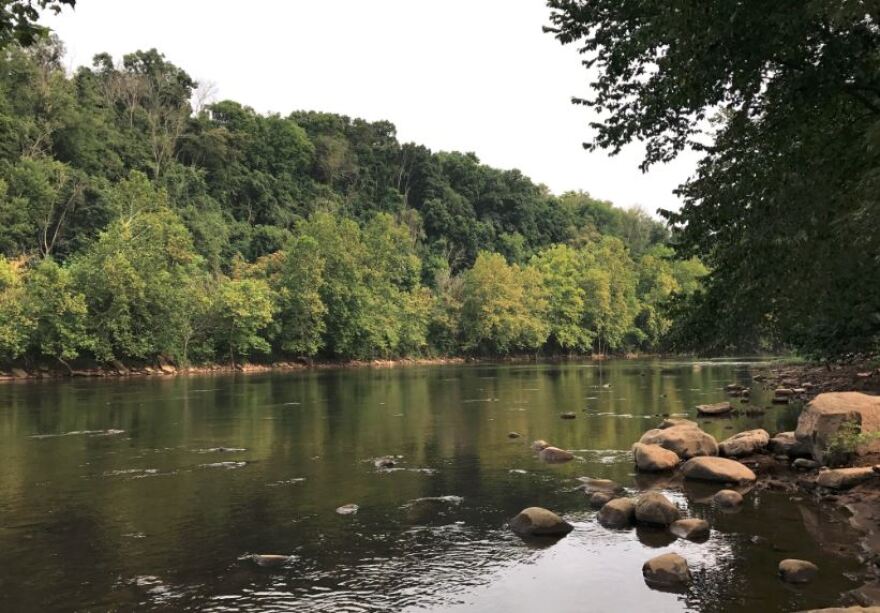A new report reveals that industrial facilities in Pennsylvania are among the top polluters of United States rivers, including a chemical company just 16 miles outside of Pittsburgh.
Three rivers, the Allegheny, Monongahela and Ohio, cross through Pittsburgh's metropolitan area. The Mon River was classified by the Pennsylvania Department of Environmental Protection as impaired, or too contaminated to drink, in 2002. That statusremained until 2014, when the DEP declared that the river's sulfate levels had dropped to acceptable levels.
But four years later, one environmental group is worried that industrial pollution threatens to make the Mon–and other Pennsylvania rivers–impaired again.
On the shores of the Mon River in the South Side on Tuesday, representatives from environmental advocacy group PennEnvironment gathered with Allegheny County Councilwoman Anita Prizio and Pittsburgh City Councilwoman-Elect Erika Strassburger, who previously worked for the statewide group.
According to the report, industrial facilities across the country exceeded federal water pollution levels 8,100 times between January 2016 and September 2017.
"Approximately 40 percent of all major industrial facilities–more than 1,100 in total–reported exceeding their pollution limits at least once," the report reads. PennEnvironment prepared their findings based on compliance data from the Environmental Protection Agency.
The group's regional director, Ashleigh Deemer, said Pennsylvania companies top the list.
"We've found that industrial facilities dumped excessive pollution into Pennsylvania waterways 633 times," she explained. "That is the second highest number of exceedances in the country, second only to Texas."
The report identifies 10 Pennsylvania companies responsible for the most water pollution. The EPA's 1972 Clean Water Act established a permit system for industrial pollution, setting limits for individual facilities.
Eastman Chemical Resins, on the banks of the Mon and upstream from Pittsburgh, is identified as the second worst with 72 exceedances over its federal permit limit in less than two years.
Of those exceedances, half were 100 percent more than Eastman Chemical's permit allows. Another 10 instances went over by more than 500 percent, exposing the Mon River to chemicals including zinc, aluminum and nitrate.
In an emailed statement to 90.5 WESA, Amanda Allman of Eastman Chemicals' corporate office said that zinc and aluminum from the company's 68-year-old building leak into the Mon River due to storm water runoff, not because of chemical production within the plant:
Despite efforts to control these discharges, neither Eastman nor the DEP [Department of Environmental Protection] has identified a technology capable of removing these metals from the storm water in order to meet the DEP imposed limits. Eastman is in the process of working with DEP to address this situation. Fortunately, the metals’ levels in the storm water do not pose a threat to human health or the environment. Please be assured that Eastman takes its license to operate and commitment to operating its facilities responsibly very seriously.
The state's top violator, according to the report, is SCI Graterford STP, a correctional facility in Montgomery County north of Philadelphia. EPA data suggest that the prison exposed the Wilson River to fecal matter, ammonia and other pollutants 80 times in less than two years.
"We should not be fearful of going in the water and drinking the water," Strassburger said. "We should feel safe and comfortable in our rivers. Unfortunately, that's not the case ... and a lot of that is due to the industrial pollution that flows illegally into our rivers every year."
Of over 500 industrial facilities studied nationwide, only six facilities surpassed Eastman Chemical and SCI Graterford–three facilities in Arkansas and one each in California, Colorado and Ohio.
PennEnvironment notes in the report that the group is concerned about the Trump Administration's proposed cuts to the EPA, which could cripple an already inefficient clean water enforcement system. The report outlines steps that local, state and federal agencies can take to lessen future exceedances, such as strengthening permits, funding more water pollution control grants, increasing inspections and issuing timely penalties.
"Although the polluters mentioned in the PennEnvironment report may not be literally in our backyard, they are upstream and should be held accountable," said Prizio. "State and federal officials must tighten enforcement of the Clean Water Act. Clearly, it is cheaper to prevent pollution than to clean up after the fact."
Deemer said she believes that Pittsburgh's waterways are just as iconic as the bridges that cross them.
"We're here overlooking the Mon River for one simple reason," she said, gesturing to the water behind her, swelling with falling rain. "Pennsylvania deserves clean water. Our rivers are literally and figuratively tied to our regional identity. The rivers are part of Pittsburgh, and we have to value them as such."
This post was updated at 3:21 p.m. on 03/29/18 to include a statement from Eastman Chemical.






